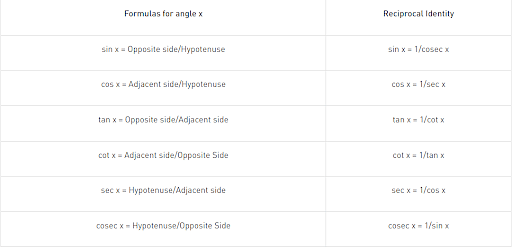If $cosec\, \theta - \cot \theta = 2017$, then quadrant in which $\theta $ lies is
- I
- IV
- III
- II
The Correct Option is D
Solution and Explanation
$\operatorname{cosec} \theta-\cot \theta=2017 \ldots(i)$
$\therefore \operatorname{cosec} \theta+\cot \theta=\frac{1}{2017} \ldots(ii)$
$\left[\begin{array}{l}\because \operatorname{cosec}^{2} \theta-\cot ^{2} \theta=1 \\ \Rightarrow \operatorname{cosec} \theta-\cot \theta=\frac{1}{\operatorname{cosec} \theta+\cot \theta}\end{array}\right]$
Adding Eqs. (i) and (ii),
we get $2 \operatorname{cosec} \theta=2017+\frac{1}{2017}$
$\Rightarrow \operatorname{cosec} \theta=\frac{1}{2}\left[2017+\frac{1}{2017}\right]>0$
$\theta$ lie in Ist or IInd quadrant.
Subtracting E (i) from E (ii), we get
$2 \cot \theta=\frac{1}{2017}-2017$
$\cot \theta=\frac{1}{2}\left(\frac{1}{2017}-2017\right) < 0$
$\therefore \theta$ lie in IInd and IIIrd quadrant.
Hence, $\theta$ lies in IInd quadrant.
Top Questions on Trigonometric Functions
- If, \(x∈(0,π)\) satisfies the equation \(6^{1+sinx+sin^2x....}=36\) ,then the value of \(x\) is_____.
- KEAM - 2023
- Mathematics
- Trigonometric Functions
- The value of a(≠0) for which the equation \(\frac{1}{2}(x-2)^2+1=\sin(\frac{a}{x})\) holds is/are
- KEAM - 2023
- Mathematics
- Trigonometric Functions
- Let P(x)=cos2x+sin4x,for any x∈R.Then which of the following options is correct for all x?
- KEAM - 2023
- Mathematics
- Trigonometric Functions
- Minimum value of 5cos(2x) + 5sin(2x)
- BITSAT - 2023
- Mathematics
- Trigonometric Functions
- If $\tan 15^{\circ}+\frac{1}{\tan 75^{\circ}}+\frac{1}{\tan 105^{\circ}}+\tan 195^{\circ}=2 a$, then the value of $\left(a+\frac{1}{a}\right)$ is :
- JEE Main - 2023
- Mathematics
- Trigonometric Functions
Questions Asked in TS EAMCET exam
If A is a square matrix of order 3, then |Adj(Adj A2)| =
- TS EAMCET - 2023
- Algebra of Complex Numbers
Match the following List -I (Complex) List II (Spin only Magnetic Moment)
List -I (Complex) List II (Spin only Magnetic Moment) A) [CoF6]3- I) 0 B) [Co(C2O4)3]3- II) √24 C) [FeF6]3+ III) √8 D) [Mn(CN)6]3- IV) √35 V) √15 the correct answer is:
- TS EAMCET - 2023
- coordination compounds
If (h,k) is the image of the point (3,4) with respect to the line 2x - 3y -5 = 0 and (l,m) is the foot of the perpendicular from (h,k) on the line 3x + 2y + 12 = 0, then lh + mk + 1 = 2x - 3y - 5 = 0.
- TS EAMCET - 2023
- Coordinate Geometry
If a line ax + 2y = k forms a triangle of area 3 sq.units with the coordinate axis and is perpendicular to the line 2x - 3y + 7 = 0, then the product of all the possible values of k is
- TS EAMCET - 2023
- Algebra of Complex Numbers
- If the solution of the differential equation \(\frac{dy}{dx}=\frac{2x+3y}{3x-2y}\) is y = xtan(f(x)) + c then f(x) =
- TS EAMCET - 2023
- Differential equations
Concepts Used:
Trigonometric Functions
The relationship between the sides and angles of a right-angle triangle is described by trigonometry functions, sometimes known as circular functions. These trigonometric functions derive the relationship between the angles and sides of a triangle. In trigonometry, there are three primary functions of sine (sin), cosine (cos), tangent (tan). The other three main functions can be derived from the primary functions as cotangent (cot), secant (sec), and cosecant (cosec).
Six Basic Trigonometric Functions:
- Sine Function: The ratio between the length of the opposite side of the triangle to the length of the hypotenuse of the triangle.
sin x = a/h
- Cosine Function: The ratio between the length of the adjacent side of the triangle to the length of the hypotenuse of the triangle.
cos x = b/h
- Tangent Function: The ratio between the length of the opposite side of the triangle to the adjacent side length.
tan x = a/b
Tan x can also be represented as sin x/cos x
- Secant Function: The reciprocal of the cosine function.
sec x = 1/cosx = h/b
- Cosecant Function: The reciprocal of the sine function.
cosec x = 1/sinx = h/a
- Cotangent Function: The reciprocal of the tangent function.
cot x = 1/tan x = b/a
Formulas of Trigonometric Functions:




